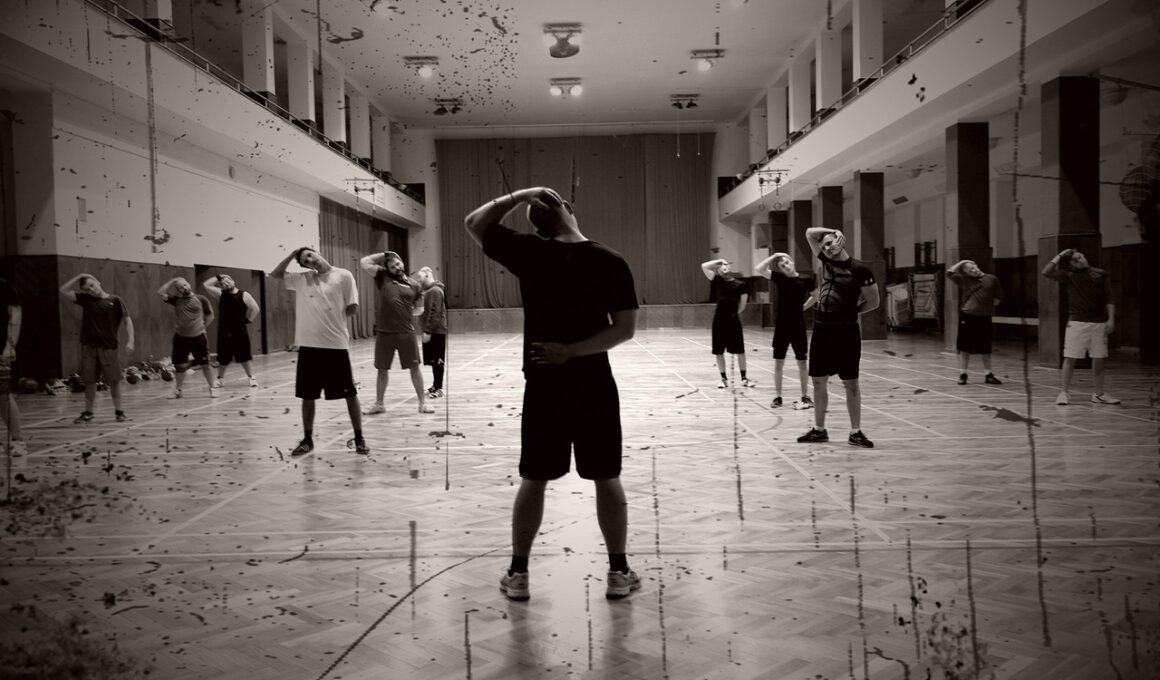Effective Warm-Up Routines for CrossFit Strength Days
Warming up effectively before engaging in CrossFit strength training is crucial to prepare your body for the high intensity that comes with it. A good warm-up serves multiple purposes; it increases blood flow to your muscles, enhances flexibility, and activates your central nervous system. Ideally, your warm-up should start with a general cardio activity, such as five to ten minutes of rowing or biking. This helps raise your heart rate and temperature, which makes your muscles more pliable. Following that, dynamic stretches focused on the major muscle groups you’ll work during your strength session are beneficial. Think leg swings, arm circles, and torso twists. These movements stimulate the relevant joints and muscles, reducing the risk of injury. Additionally, incorporating specific strength movements at lower intensity can also be quite effective. Gradually increasing weight during the warm-up sets allows your body to adapt, ensuring you’re prepared for the heavy lifts. Effective warm-up routines can set the tone for your overall performance, making it essential to commit some time to this crucial part of your training.
When discussing effective warm-up routines, mobility work should never be overlooked. Mobility drills specifically target the movements necessary for strength training, enhancing the range of motion for key lifts like squats, deadlifts, and presses. For instance, exercises like the hip flexor stretch, thoracic spine opener, or shoulder dislocates can improve flexibility and performance for these lifts. Before you begin your main workout, consider taking five to ten minutes to focus on tailored mobility drills. This not only preempts injuries but also allows for more optimal lifting mechanics. Engaging in these drills can facilitate better movement patterns, enabling you to lift heavier weight more safely. A common inclusion in mobility routines are foam rollers or massage balls, which help in myofascial release, further assisting muscle preparation. Spend even a few minutes on target areas can improve your overall lifting capacity. Moreover, if your gym lacks sufficient mobility equipment, you can easily integrate similar moves using your body weight or lighter alternatives. Ultimately, the goal of mobility work in the warm-up is to help your joints and muscles achieve their full movement potential.
Specific Warm-Up Sets for Strength Training
Moreover, incorporating specific warm-up sets plays a pivotal role in ensuring that your body is well-prepared for the strength training ahead. After completing your general warm-up and mobility work, start your lifting routine with lighter weight versions of the upcoming exercises. For example, if you plan to perform back squats, begin with the empty barbell or light weights to practice your form and technique. Doing this will allow your muscles to activate and adapt to the lifting movement without overloading them. Make use of 50% of your estimated working weight for the first warm-up set and then increase it gradually to about 70% for the next. This gradual buildup assists in mental preparation as well, allowing you to focus more on your technique and less on your desired weight. It’s essential during these warm-up sets to maintain good form, as this sets the standard for your working sets. Focusing on your breathing, posture, and movement quality during these lighter sets will translate directly to your performance during your actual workout.
After your specific warm-up, don’t skip out on sport-specific movements to round off your preparation. Sport-specific movements refer to exercises that mimic the movements you’ll be performing in your primary workout. These help activate the appropriate muscle groups dynamically and mentally prepare you for what’s to come. For instance, if your strength day includes deadlifts, doing kettlebell swings or Romanian deadlifts at a light weight can effectively prime your posterior chain. Incorporating such movements ensures that all relevant muscles are not only warmed up but also fully engaged. When these specific movements are seamless and flow naturally into your workout, it ensures a smoother transition and improved lifting performance. Additionally, performing lighter versions of your main lifts can increase kinesthetic awareness, letting you feel how each lift should ideally perform. This is where you can focus on your grip, stance, and tension — factors that are crucial for optimal lifting. Ultimately, sport-specific movements act as both a physical warm-up and a mental rehearsal for the intensity of your actual workout.
Benefits of a Well-Planned Warm-Up
The importance of a structured warm-up routine can’t be emphasized enough. With a well-planned warm-up, not only do you minimize your risk of injury, but you also enhance your overall performance during your workout. An effective warm-up allows your muscles, joints, and nervous system to work together efficiently, leading to better strength gains. Blood flow and flexibility are improved considerably, enabling you to lift heavier weights or push for more reps. Beyond the physical benefits, a well-thought-out warm-up can enhance focus and mental clarity, preparing yourself for the challenge ahead. Engaging in routine warm-up exercises can even establish healthy habits, encouraging greater consistency in your strength training. Additionally, as you build a connection with your body through this process, it becomes easier to tune in and recognize any discomfort or issues, further promoting injury prevention. Not to mention, a proper warm-up also serves as a mental buffer, transitioning you from your day-to-day activities into a focused training mindset. The ritual of warming up can thus cultivate a deeper commitment to your overall training regimen.
Realizing the rewards of a proper warm-up can also enhance your enjoyment of the workout experience. You’ll find that activating your muscles prepares you not only physically but also mentally for the rigorous session ahead. This feeling of readiness positively impacts your mindset, resulting in improved workout satisfaction. Creating enjoyable warm-up routines that challenge your body while keeping you engaged can further elevate your enthusiasm. As you rotate various elements into your warm-up, it maintains excitement and novelty in your routine. Plus, if you engage with training partners, these routines can also be a collaborative experience. You can work together on dynamic stretches or sport-specific movements, making the whole process more social and fun. Lastly, you may find it advantageous to track your warm-up routines over time. This tracking can help identify which warm-ups yield the best performance results, allowing you to fine-tune your regimen. Once you embrace the significance of warm-ups, you open the door to enhancing your CrossFit strength training experience, establishing a deeper bond with the training process.
Conclusion
In conclusion, dedicating the necessary time and effort to an effective warm-up routine will most certainly boost your performance and reduce the risk of injury. Each component of the warm-up, from general cardio and mobility work to specific warm-up sets, plays an integral role in preparing your body for strength training. Understanding the unique requirements for warming up in CrossFit strength training is essential for improving both physical performance and mental focus. As you begin implementing these targeted routines, take note of how your workouts transform. Warm-ups should evolve alongside your personal progress, adapting to the changing needs of your training journey. Stay consistent and intentional with your approach, for this investment in your warm-up can yield significant dividends during your strength training sessions. Recognize that even on the days when motivation wanes, maintaining your warm-up routine safeguards against injury and prepares you mentally to charge forward with confidence. Commit fully to ensuring that your body is primed and ready for the lifts awaiting ahead. Ultimately, a solid warm-up routine not only enhances your lifting capacity but can also foster a more enjoyable CrossFit experience overall.
Finally, remember that the importance of warm-ups extends beyond physical benefits. They also play a vital role in establishing camaraderie among training peers. Sharing the warm-up process enables relationships to flourish, enhancing the atmosphere of your training environment. Consider inviting friends to join your warm-up routines, creating a shared space where everyone can benefit together. This can foster support within your community and establish a culture that values training as a collective experience. Participating in partner warm-ups offers a fun way to motivate one another, pushing your limits while adhering to safety protocols. Plus, introducing a social element can transform your training into an enjoyable experience rather than a solitary pursuit. Connecting with others through warm-ups can also inspire you to adopt new techniques or movements you may not have explored otherwise. Hence, fostering a vibrant training culture goes hand in hand with the benefits of a well-thought-out warm-up. The combination of a physically prepared body, a focused mindset, and a sense of community can have a lasting impact on your CrossFit journey, encouraging lifelong participation in this dynamic and rewarding fitness approach.


